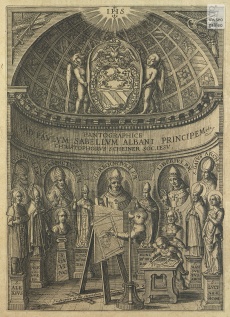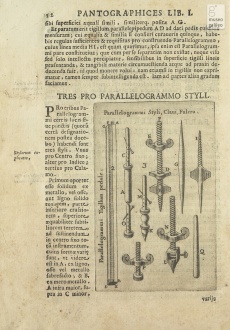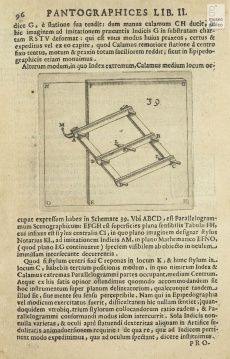Pantograph
From Inventions
| Line 19: | Line 19: | ||
| - | |strumentiesistenti= [http://catalogue.museogalileo.it/object/Pantograph.html Firenze, Museo Galileo-Istituto di Storia della Scienza, Inv. 596] | + | |strumentiesistenti= |
| + | - Museo Galileo, Institute and Museum of the History of Science, Florence <br> | ||
| + | [http://catalogue.museogalileo.it/object/Pantograph.html Firenze, Museo Galileo-Istituto di Storia della Scienza, Inv. 596] | ||
| - | + | ||
| + | |||
| + | - Musée des arts et métiers, Paris<br> | ||
| + | [http://cugnot.cnam.fr:8000/SEARCH/BASIS/collec/internet/objet/DDW?W%3DDESIG+PH+WORDS+%27Pantographe+%27+ORDER+BY+DESIG/Ascend%26M%3D6%26K%3D20864%26R%3DY%26U%3D1 Paris, Musée des arts et metiers, inv. 01474-0000-] <br /> | ||
| + | |||
| + | |||
| + | - Museum of the History of Science, Oxford <br> | ||
| + | [http://emu.mhs.ox.ac.uk/Display.php?irn=10060&QueryPage Museum of the History of Science, Oxford, inv. 35660]<br> | ||
| + | [http://emu.mhs.ox.ac.uk/Display.php?irn=2728&QueryPage Museum of the History of Science, Oxford, inv. 37396]<br> | ||
| + | [http://emu.mhs.ox.ac.uk/Display.php?irn=1932&QueryPage Museum of the History of Science, Oxford, inv. 43506]<br> | ||
| + | |||
| + | |||
| + | |||
| + | |||
| + | |link= | ||
| + | http://catalogo.museogalileo.it/approfondimento/Pantografo.html (Italian) <br> | ||
| + | http://db-maths.nuxit.net/CARzine/articles/art93/ (French)<br> | ||
| + | http://www.cca.qc.ca/en/collection/544-drawing-instruments-pantograph (English)<br> | ||
| + | http://www.ies.co.jp/math/java/geo/panta/panta.html (English)<br> | ||
| + | http://maven.smith.edu/~orourke/DTS/pantograph.html (English)<br> | ||
| + | http://www.green-trust.org/junkyardprojects/FreeMiscellaneousPlans/Pantograph.pdf (English) | ||
|immagini= <gallery widths=230 heights=368 perrow=3> | |immagini= <gallery widths=230 heights=368 perrow=3> | ||
Current revision as of 11:31, 8 September 2010
Name coined by the inventor, taken from the Greek pantos (of all) and graphein (to paint).
Contents |
Inventor
Christoph Scheiner (1573-1650)
Historic Period
1603
Description
Instrument invented by the Jesuit Father Christoph Scheiner to copy drawings on a different scale. It consists of four rods hinged together to form a parallelogram, with the hinge points varying in relation to the scale of reproduction. It has a fixed centre and two points: a dry point that follows the contour of the original drawing, and a pen point that traces the reproduction in enlarged or reduced form. To enlarge a drawing, the index is positioned between the fixed centre and the pen. To reduce it, the pen is positioned between the fixed centre and the index. To copy a drawing on the same scale, the index and the pen are equidistant from the fixed centre. As stated at the beginning of the treatise, "This Art of Drawing was invented in the year 1603 in Dillingen, a German city, by a certain Painter friend of the Author, who, recounting how he could carry out some of the operations proper to this Art, but kept secret the manner of doing so (as a Divine thing) and describing a Compass, which he said he used, moved the soul of the Father, as he was most ingenious and an excellent Mathematician, to speculate endlessly, until in a few days’ time he discovered all of the Art, and corroborated it with mathematical demonstrations". This compass-like instrument was used especially to reproduce artistic, architectural and cartographic drawings. Moreover, when suitably mounted on a drawing board, it could also be used to make perspective drawings from life and even anamorphic drawings, as stated in the treatise: "We can with the same Parallelogram... Draw in plan anything appearing in the distance, whether it be a town, mountain, Island, Fortress, City or villa... With this machine we can easily carry out various operations hitherto deemed most difficult by Painters; such as Painting on a wall, or on a ceiling, either flat or curved, regular or irregular, a Perspective of houses, loggias, or other figures... With this same machine we can just as easily form those elongated figures, whose shape has been deformed by their exaggerated length but which, when observed from a certain established point, appear properly proportioned. These figures are discussed in the Prospettivi pratici [Practical perspective] and among others by Guid'Ubaldo, and Pietro Accolti in his Inganno de gli occhi [Deceiving the eye] part I, chap. 36. This operation can be easily done by inclining the Plane very obliquely from the optical Axis."
Bibliographical Resources
Scheiner, Christoph. Pantographice, seu ars delineandi res quaslibet per parallelogrammum lineare seu cavum, mechanicum, mobile: libellis duobus explicata, et demonstrationibus geometricis illustrata quorum prior epipedographicen, sive planorum, posterior stereographicen, seu solidorum aspectabilium vivam imitationem atque proiectionem edocet. Romae, Ex typographia Ludovici Grignani, sumptibus Hermanni Scheus, 1631, cap. VIII, l. I, pt. II, prop. VII, p. 60; l. II, prop. VIII, prob. VI, corollaria III, p. 108
Scheiner, Christoph. Pratica del parallelogrammo da disegnare del P. Christoforo Scheiner... nella quale s'insegna una nuova arte di disegnare. In Padova, per Sebast. Sardi, 1637.
Burja, Abel. Der mathematische Maler oder gründlische Anweisung zur Perspektive nach verschiedenen Methoden; nebst einem Anhange über die theatralische Perspektive und der Beschreibung eines neuen perspektivischen Instruments, Berlino, 1795, Appendice seconda.
Existing Instruments
- Museo Galileo, Institute and Museum of the History of Science, Florence
Firenze, Museo Galileo-Istituto di Storia della Scienza, Inv. 596
- Musée des arts et métiers, Paris
Paris, Musée des arts et metiers, inv. 01474-0000-
- Museum of the History of Science, Oxford
Museum of the History of Science, Oxford, inv. 35660
Museum of the History of Science, Oxford, inv. 37396
Museum of the History of Science, Oxford, inv. 43506
Links (External)
http://catalogo.museogalileo.it/approfondimento/Pantografo.html (Italian)
http://db-maths.nuxit.net/CARzine/articles/art93/ (French)
http://www.cca.qc.ca/en/collection/544-drawing-instruments-pantograph (English)
http://www.ies.co.jp/math/java/geo/panta/panta.html (English)
http://maven.smith.edu/~orourke/DTS/pantograph.html (English)
http://www.green-trust.org/junkyardprojects/FreeMiscellaneousPlans/Pantograph.pdf (English)
Images
Author of the entry: Filippo Camerota




